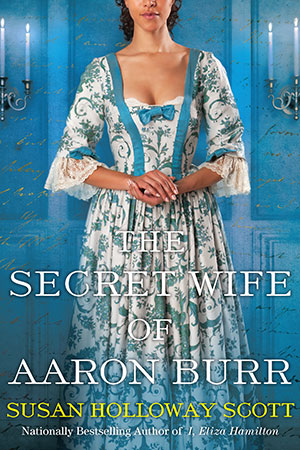Susan reporting,
As I've noted in previous blog posts (
here and
here), sometimes the most inspiring historical research isn't found in books, diaries, or letters, but in the physical objects that can offer an immediate connection to the past. I've saved the best of these from my research for my just-released historical novel
I, Eliza Hamilton until now - and here it is.
Kept in an acid-free box in the Rare Book & Manuscript Library at Columbia University in New York City, and tiny in size, it's only brought out by special request, or for the even-more-rare times that it appears on display as part of an exhibition.
Made of gold grown burnished with time in the way that only wedding rings can be, Eliza's ring is impossibly delicate, worn thin and no longer exactly round after nearly seventy-four years on her finger. It's small, too, for Eliza was a petite woman. I wasn't permitted to try it on (nor would I have wished to: that's Eliza's ring), but when I placed my own size-5 ring beside it, mine looked large and thick by comparison.
The style is ingenious. It's called a gimmel ring (or gimmal, or puzzle ring), with two separate, twisted circles that are linked and fit together side by side to form a single band. Gimmel rings had already been popular for betrothals and weddings long before Alexander bought one for Eliza, with the earliest known examples dating from the 14th century. I made
this very brief video showing the curator linking the rings together. If you look closely, you can see the little notch and peg that clicked the rings together.
The symbolism of two forming one is perfect for a marriage, and this ring was made even more special by having the names of the groom and bride - Alexander & Elizabeth (he got the ampersand) - engraved inside each ring, where they were always pressed against one another. Without the added enhancement of precious stones, this was a comparatively inexpensive ring, which was likely a consideration for the impoverished young lieutenant colonel in the middle of the American Revolution.
But I also imagine that the simplicity of the ring must have appealed to Eliza as well. There on her finger, the gold band must have been a constant comfort to her, a reminder of love and happiness through the tragedies and sorrows of her life, and through the half-century - more than fifty years! - of her widowhood.
Given that, I'm surprised that the ring was not buried with her. Yet I'm glad it wasn't. Seeing this little double-circle of gold, touching it lightly with my fingertip, was like having Eliza herself there beside me in the library. Research doesn't get any better - or more magical - than that.
Many thanks to Jennifer B. Lee, Curator, Rare Book & Manuscript Library, Columbia University, for showing me the ring along with other Hamilton memorabilia.
Above: Gold double-band wedding ring of Elizabeth Schuyler Hamilton, wife of Alexander Hamilton, maker unknown, 1780. Columbia University; gift of Furman University Library, through the suggestion and assistance of the Hamilton family descendants: Mrs. Marie Hamilton Barrett and Mrs. Elizabeth Schuyler Campbell.
Read more about Eliza Schuyler and Alexander Hamilton in my latest historical novel, I, Eliza Hamilton, now available everywhere.









 One of us --
One of us -- 


